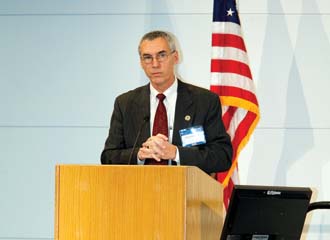Doing More With Less
Richard Spires, chief information officer, U.S. Department of Homeland Security (DHS), says the theme for fiscal year 2012 is "as a service," referring to the U.S. government’s move to cloud computing. Spires led the DHS chief information officer council public meeting at the DHS Information Technology Industry Day prior to the AFCEA International Homeland Security Conference.
Homeland security agencies need to spend their limited funding wisely, and they have the cash to invest in technologies that lead to efficiencies. 
U.S. government departments may be facing deep budget cuts, but companies could end up on top if they listen closely to agencies’ priorities. At the top of the list are cloud computing, cybersecurity, mobility and information sharing between government and industry. Funding is available in a number of new areas—including public safety—and the efforts to be more efficient require innovative business models.
Leaders from government and industry discussed these topics at AFCEA International’s Homeland Security Conference, Washington, D.C. The U.S. Department of Homeland Security (DHS) conducted its information technology industry day on February 28, which was followed by the two-day AFCEA conference.
Among the foremost topics was the new Federal Risk and Authorization Management Program (FedRAMP), which was established on December 8, 2011. The program calls for a standardized approach to security assessment, authorization and continuous monitoring for cloud products and services. FedRAMP is scheduled to achieve initial operating capability by early June.
According to Bajinder N. Paul, deputy associate administrator, Office of Citizen Services and Innovative Technologies, U.S. General Services Administration, Washington, D.C., the security that FedRAMP defines will be a key enabler for cloud computing. The program addresses the fragmented approach agencies have had in adopting cloud computing by offering various flexible models and leveraging cloud benefits by providing singular guidance, he added. Keith Tripple, executive director of enterprise system development, DHS, pointed out that as part of FedRAMP, agencies will need to consider costs and security trade-offs, but they will be able to obtain at least an 80 percent technical solution rather than waiting five years for a 100 percent solution that by then is obsolete.
Agile acquisition also was a topic of discussion during the conference. A number of DHS representatives called for improved government-industry dialogue, asking for more responses to requests for information, or RFIs. According to Dennis Smiley, executive director, enterprise acquisition and information technology at the DHS, his agency is interested not only in specific technical solutions but also in learning best practices and understanding when existing programs are going off track.
Kevin Boshears, director, Office of Small Business and Disadvantaged Business, DHS, pointed out that the Federal Acquisition Regulation underwent some significant changes in November 2011. One of the most noteworthy adjustments is the definition of a small business under the North American Industry Classification System (NAICS). As of March 2012, the revenue definition of a NAICS code 541611 company increased from $7 million to $14 million.
Small business owners also received advice from government and industry leaders during a panel that focused solely on their interest in doing business with the DHS. In addition to making personal relationships with government procurement officers a priority, the panelists recommended that entrepreneurs decide “what they want to be when they grow up” early in their business strategies. When small business owners want to team with large companies or provide solutions to government agencies, they must come to the table with solid examples. These must include the solutions their product or service will bring to a contract team or how they will address a specific problem an agency faces.
Paul Sullivan, chief executive officer, Cyber Space Solutions and DHS protégé of L-3 Stratis, said it is important that small businesses choose large companies who believe in their technologies and services. “When you get in a true relationship [with a company] that wants to learn from you, then you’ve got something good,” he stated. Both large and small companies must remember that partnerships are give-and-take and involve both collaboration and cooperation, Sullivan added.
Some of the best revenue news came out of the panel discussing wireless broadband and the public safety sector. H.R. 3630 Title VI may be buried within the Middle Class Tax Relief and Job Creation Act, which President Obama signed into law in February, but it has big financial implications for industry. The Federal Communications Commission currently is organizing the Public Safety Advisory Board, and requests for proposals seeking technologies that leverage wireless infrastructure are being issued. A total of $7 billion is being placed in the Public Safety Trust Fund, with $2 billion of this total released before the spectrum auction occurs. The National Institute of Standards and Technology is responsible for research and development with $100 million in initial funding and an additional $200 million if the auction brings in more than $27.6 billion.
In-depth coverage of the AFCEA International Homeland Security Conference is available online at http://Bit.ly/homeland2012.



